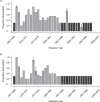The Relationship Between School Holidays and Transmission of Influenza in England and Wales
- PMID: 27744384
- PMCID: PMC5860259
- DOI: 10.1093/aje/kww083
The Relationship Between School Holidays and Transmission of Influenza in England and Wales
Abstract
School closure is often considered as an influenza control measure, but its effects on transmission are poorly understood. We used 2 approaches to estimate how school holidays affect the contact parameter (the per capita rate of contact sufficient for infection transmission) for influenza using primary care data from England and Wales (1967-2000). Firstly, we fitted an age-structured susceptible-infectious-recovered model to each year's data to estimate the proportional change in the contact parameter during school holidays as compared with termtime. Secondly, we calculated the percentage difference in the contact parameter between holidays and termtime from weekly values of the contact parameter, estimated directly from simple mass-action models. Estimates were combined using random-effects meta-analysis, where appropriate. From fitting to the data, the difference in the contact parameter among children aged 5-14 years during holidays as compared with termtime ranged from a 36% reduction to a 17% increase; estimates were too heterogeneous for meta-analysis. Based on the simple mass-action model, the contact parameter was 17% (95% confidence interval: 10, 25) lower during holidays than during termtime. Results were robust to the assumed proportions of infections that were reported and individuals who were susceptible when the influenza season started. We conclude that school closure may reduce transmission during influenza outbreaks.
Keywords: disease transmission; human; schools; infectious; influenza.
© The Author 2016. Published by Oxford University Press on behalf of the Johns Hopkins Bloomberg School of Public Health. All rights reserved. For permissions, please e-mail: journals.permissions@oup.com.
Figures



Comment in
-
School closure, COVID-19 and lunch programme: Unprecedented undernutrition crisis in low-middle income countries.J Paediatr Child Health. 2020 Jul;56(7):1013-1017. doi: 10.1111/jpc.15018. Epub 2020 Jul 3. J Paediatr Child Health. 2020. PMID: 32619327 Free PMC article.
References
-
- Fleming DM. The contribution of influenza to combined acute respiratory infections, hospital admissions, and deaths in winter. Commun Dis Public Health. 2000;3(1):32–38. - PubMed
MeSH terms
Grants and funding
LinkOut - more resources
Full Text Sources
Other Literature Sources
Medical

